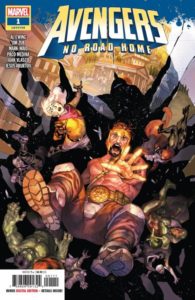 Avengers: No Road Home #1 (of 10) (Legacy #708) — Writers: Mark Waid, Al Ewing and Jim Zub; Pencils: Paco Medina; Inks: Juan Vlasco; Colors: Jesus Aburtov
Avengers: No Road Home #1 (of 10) (Legacy #708) — Writers: Mark Waid, Al Ewing and Jim Zub; Pencils: Paco Medina; Inks: Juan Vlasco; Colors: Jesus Aburtov
Savage Sword of Conan #1 (Legacy #236) — Writer: Gerry Duggan; Art: Ron Garney; Colors: Richard Isanove
Next Gen #1 (of 5) — Writer: Ed Brisson; Art: Marcus To; Colors: Justin Ponsor
Marvels Annotated #1 (of 4) — Writers: Kurt Busiek, Alex Ross and Steve Darnell; Art/Colors: Alex Ross
Marvel Tales: Black Widow #1 (of 1) — Creators: Various
Avengers: No Road Home is by the same creative team as last year’s Avengers: No 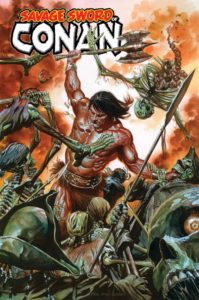 Surrender; like that series, it’s a ten-issue weekly story that’s part of the regular comic’s “legacy” numbering. No Surrender was a fast-moving, widescreen ride with dozens of characters and cosmic consequences, and this looks to be the same: darkness falls across, not just Earth, but the universe, and a group: Hercules, Scarlet Witch, the Hulk, Hawkeye, Rocket Raccoon, the Vision and Voyager, the daughter of the Gamesmaster from the previous series, all end up in Olympus, where all the gods have been killed, to meet the Big Bad New Villain. It’s refreshing to read a “big event” like this that’s self-contained, without spin-offs or tie-ins, and the quick-reward weekly schedule makes the serial nature of the story effective, too — it’s a comic where you really want the weekly what-happens-next fix instead of waiting for the trade collection. Get it; it’s about as good as corporate-owned superhero comics can be. Savage Sword of Conan revives the title of that long-running ’70s-’90s
Surrender; like that series, it’s a ten-issue weekly story that’s part of the regular comic’s “legacy” numbering. No Surrender was a fast-moving, widescreen ride with dozens of characters and cosmic consequences, and this looks to be the same: darkness falls across, not just Earth, but the universe, and a group: Hercules, Scarlet Witch, the Hulk, Hawkeye, Rocket Raccoon, the Vision and Voyager, the daughter of the Gamesmaster from the previous series, all end up in Olympus, where all the gods have been killed, to meet the Big Bad New Villain. It’s refreshing to read a “big event” like this that’s self-contained, without spin-offs or tie-ins, and the quick-reward weekly schedule makes the serial nature of the story effective, too — it’s a comic where you really want the weekly what-happens-next fix instead of waiting for the trade collection. Get it; it’s about as good as corporate-owned superhero comics can be. Savage Sword of Conan revives the title of that long-running ’70s-’90s 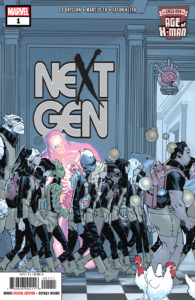 black-and-white magazine, but in regular (if double-sized) color comics format; it’s 30 pages of story along with six of editorial material, and Ron Garney does a good job of recreating the gritty barbarian buzz of those original magazine issues, especially on a couple of effective splash pages; if you’re a Conan fan, you should like this a lot. Next Gen begins the second of the various five-issue mini-series associated with the Age of X-Man event currently running through the Marvel mutant universe, wherein the uber-powerful Nate Gray has transported most of the principles to a utopian future where everyone has genetic-based powers, and everything’s great — except, of course, that it isn’t. Here, the younger student members of the X-Men, between classes and relationship stuff, begin to realize that their perfect society has a dark underpinning; their response will presumably be the spine
black-and-white magazine, but in regular (if double-sized) color comics format; it’s 30 pages of story along with six of editorial material, and Ron Garney does a good job of recreating the gritty barbarian buzz of those original magazine issues, especially on a couple of effective splash pages; if you’re a Conan fan, you should like this a lot. Next Gen begins the second of the various five-issue mini-series associated with the Age of X-Man event currently running through the Marvel mutant universe, wherein the uber-powerful Nate Gray has transported most of the principles to a utopian future where everyone has genetic-based powers, and everything’s great — except, of course, that it isn’t. Here, the younger student members of the X-Men, between classes and relationship stuff, begin to realize that their perfect society has a dark underpinning; their response will presumably be the spine 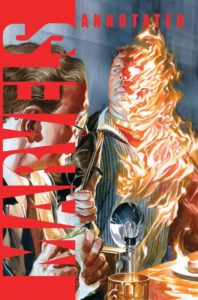 of the series. As with Conan, if you’re a fan of the characters and their “regular” world, you’ll probably like this iteration of it. Two jumbo-sized reprint books also debut from Marvel this week; Marvels Annotated takes that now-25-year-old much-beloved mini-series, and gives it a “director’s cut” version, with both the “0” issue (which was mostly Alex Ross’s original presentation to convince editors to greenlight the series) and the actual first issue reprinted, along with commentary from Ross and writer/collaborator Kurt Busiek; there’s also Busiek’s full script for the first issue. It was a groundbreaking story when it first came out — and made Ross’s reputation — and getting the original tale, plus all the extra material, more than justifies the $7.99 price. The other reprint book is under the Marvel Tales imprint, and collects a number of Black Widow stories — her first appearance, as an Iron Man villain, from Tales of Suspense #52 (by Stan Lee, N. Korok
of the series. As with Conan, if you’re a fan of the characters and their “regular” world, you’ll probably like this iteration of it. Two jumbo-sized reprint books also debut from Marvel this week; Marvels Annotated takes that now-25-year-old much-beloved mini-series, and gives it a “director’s cut” version, with both the “0” issue (which was mostly Alex Ross’s original presentation to convince editors to greenlight the series) and the actual first issue reprinted, along with commentary from Ross and writer/collaborator Kurt Busiek; there’s also Busiek’s full script for the first issue. It was a groundbreaking story when it first came out — and made Ross’s reputation — and getting the original tale, plus all the extra material, more than justifies the $7.99 price. The other reprint book is under the Marvel Tales imprint, and collects a number of Black Widow stories — her first appearance, as an Iron Man villain, from Tales of Suspense #52 (by Stan Lee, N. Korok 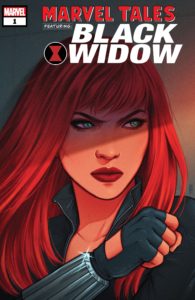 and Don Heck); a team-up in Amazing Spider-Man #86 (by Lee, John Romita and Jim Mooney); her first solo series, from Amazing Adventures #1 (by Gary Friedrich, John Buscema and John Verpooten), and the first part of a four-part serial in Marvel Premiere #10 (by Ralph Macchio, George Perez and Brett Breeding); there’s also a short ’50s mystery tale from Mystic Comics, using the name of the character but not really her, and the first chapter of the more-recent Red Widow: First Strike, by Margaret Stohl and Nico Leon. That’s a lot for your $7.99 — and it even includes the original covers of all the comics, plus a two-page essay on the character by Macchio; if all the Marvel 80th-anniversary specials pack in this much good material, they’ll be worth looking forward to.
and Don Heck); a team-up in Amazing Spider-Man #86 (by Lee, John Romita and Jim Mooney); her first solo series, from Amazing Adventures #1 (by Gary Friedrich, John Buscema and John Verpooten), and the first part of a four-part serial in Marvel Premiere #10 (by Ralph Macchio, George Perez and Brett Breeding); there’s also a short ’50s mystery tale from Mystic Comics, using the name of the character but not really her, and the first chapter of the more-recent Red Widow: First Strike, by Margaret Stohl and Nico Leon. That’s a lot for your $7.99 — and it even includes the original covers of all the comics, plus a two-page essay on the character by Macchio; if all the Marvel 80th-anniversary specials pack in this much good material, they’ll be worth looking forward to.
 Ms. Marvel #38 (Legacy #57) — Writer: G. Willow Wilson with Devin Grayson, Eve L. Ewing, Jim Zub and Saladin Ahmed; Art: Nico Leon, Takeshi Miyazawa, Joey Vazquez, Kevin Libranda, Minkyu Jung and Juan Vlasco; Colors: Ian Herring
Ms. Marvel #38 (Legacy #57) — Writer: G. Willow Wilson with Devin Grayson, Eve L. Ewing, Jim Zub and Saladin Ahmed; Art: Nico Leon, Takeshi Miyazawa, Joey Vazquez, Kevin Libranda, Minkyu Jung and Juan Vlasco; Colors: Ian Herring
The Unbeatable Squirrel Girl #41 — Writer: Ryan North; Art: Naomi Franquiz; Colors: Rico Renzi
Runaways #18 — Writer: Rainbow Rowell; Art: Kris Anka; Colors: Matthew Wilson
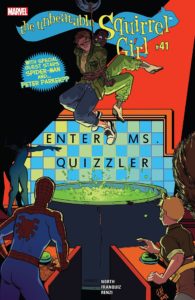 Spider-Gwen: Ghost Spider #5 — Writer: Seanan McGuire; Art: Takeshi Miyazawa; Colors: Ian Herring
Spider-Gwen: Ghost Spider #5 — Writer: Seanan McGuire; Art: Takeshi Miyazawa; Colors: Ian Herring
Ironheart #3 — Writer: Eve L. Ewing; Art: Luciano Vecchio; Layouts: Geoffo; Colors: Matt Milla
Ms. Marvel #38 is notable because it’s the last issue written by G. Willow Wilson, who’s been guiding the adventures of Kamala Khan since her beginning, five years ago; it’s the occasion for a jam-session story with a wraparound section  by Wilson, pages by a number of artists associated with the character, and some guest writers too — including Saladin Ahmed, who’ll by chronicling her exploits as Wilson’s replacement. Wilson also contributes a gracious essay thanking fans, and expressing her astonishment that a title she expected to last a year at best has become a big, and influential, bestseller, especially to the Scholastic Books/YA audience; the story itself has just the combination of superhero action, high-school relationship and family drama, and themes of friendship, tolerance and responsibility that have made it such a hit, especially with younger readers. That audience,
by Wilson, pages by a number of artists associated with the character, and some guest writers too — including Saladin Ahmed, who’ll by chronicling her exploits as Wilson’s replacement. Wilson also contributes a gracious essay thanking fans, and expressing her astonishment that a title she expected to last a year at best has become a big, and influential, bestseller, especially to the Scholastic Books/YA audience; the story itself has just the combination of superhero action, high-school relationship and family drama, and themes of friendship, tolerance and responsibility that have made it such a hit, especially with younger readers. That audience,  and books aimed at it, have been the source for many of Marvel’s best titles in this decade, ones that often get ignored by the older fans who frequent comics shops. Witness The Unbeatable Squirrel Girl, another massive hit in scholastic-trade editions, but one with much lower sales as a monthly floppy; the weekly Wednesday warriors who ignore it are missing a consistently funny, charming superhero romp — and this week’s one-shot tale about a Riddler-like villain is a perfect chance to see what makes it work so well. Runaways was a precursor to books like this — Brian K. Vaughan created it in 2004, but its adolescent-centric characters and themes — evil parents! Super-
and books aimed at it, have been the source for many of Marvel’s best titles in this decade, ones that often get ignored by the older fans who frequent comics shops. Witness The Unbeatable Squirrel Girl, another massive hit in scholastic-trade editions, but one with much lower sales as a monthly floppy; the weekly Wednesday warriors who ignore it are missing a consistently funny, charming superhero romp — and this week’s one-shot tale about a Riddler-like villain is a perfect chance to see what makes it work so well. Runaways was a precursor to books like this — Brian K. Vaughan created it in 2004, but its adolescent-centric characters and themes — evil parents! Super- powers! Relationship angst! — has made it an enduring property, as viewers of the TV show can testify. Its latest volume concludes an arc this week, and the Rainbow Rowell/Kris Anka team have played to those strengths with smart, back-to-basics plots and sleek modern-looking art. Spider-Gwen: Ghost Spider and Ironheart mine the same veins: brainy, responsible-but-flawed high-school-age protagonists who are different from the usual single straight white guys, but attract readers with cool powers, supporting casts and relationships that, while exaggerated for dramatic effect, still feel true to life, and clear, minimalist, just-manga-enough visuals that hum with energy.
powers! Relationship angst! — has made it an enduring property, as viewers of the TV show can testify. Its latest volume concludes an arc this week, and the Rainbow Rowell/Kris Anka team have played to those strengths with smart, back-to-basics plots and sleek modern-looking art. Spider-Gwen: Ghost Spider and Ironheart mine the same veins: brainy, responsible-but-flawed high-school-age protagonists who are different from the usual single straight white guys, but attract readers with cool powers, supporting casts and relationships that, while exaggerated for dramatic effect, still feel true to life, and clear, minimalist, just-manga-enough visuals that hum with energy.
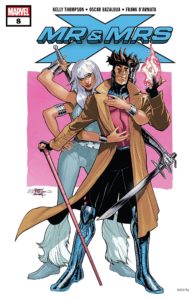 Mr. and Mrs. X #8 — Writer: Kelly Thompson; Art: Oscar Bazaldua; Colors: Frank D’Armata
Mr. and Mrs. X #8 — Writer: Kelly Thompson; Art: Oscar Bazaldua; Colors: Frank D’Armata
Captain Marvel #2 — Writer: Kelly Thompson; Art: Carmen Carnero; Colors: Tamra Bonvillain
True Believers: Captain Mar-Vell #1 (of 1) — Writer: Stan Lee; Pencils: Gene Colan; Inks: Frank Giacoia
True Believers: Captain Marvel Vs. Ronan #1 (of 1) — Writer: Steve Englehart; Pencils: Al Milgrom; Inks: Bernie Wrightson, Craig Russell, Bob McLeod, Terry Austin and Al Milgrom; Colors: Phil Rachelson
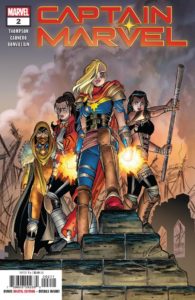 Amazing Spider-Man #15 (Legacy #816) — Writer: Nick Spencer; Pencils: Chris Bachalo; Inks: Five Different Guys; Colors: Chris Bachalo and Jim Campbell
Amazing Spider-Man #15 (Legacy #816) — Writer: Nick Spencer; Pencils: Chris Bachalo; Inks: Five Different Guys; Colors: Chris Bachalo and Jim Campbell
Thor #10 (Legacy #716) — Writer: Jason Aaron; Art: Mike del Mundo; Colors: del Mundo and Marco D’Alfonso
Kelly Thompson’s talent is to be able to meld regular superhero continuity — based on an affectionate knowledge for the characters that impresses older fans — with the cheerful optimism and confident role-model heroes that attract the younger scholastic readers too. Mr. and Mrs. X 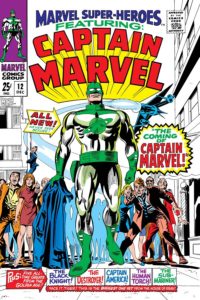 is by someone who’s obviously read a ton of X-Men comics, loves the Gambit/Rogue relationship, and knows exactly how to put that star-crossed pair through conflict but make sure they come out intact and together; Oscar Bazuldua gives it just the right dark fairy-tale sparkle. Captain Marvel, especially the modern incarnation first helmed by Kelly Sue DeConnick in 2012, is right in Thompson’s wheelhouse: deep-rooted connections to Marvel Universe history, with the same bold won’t-give-up personality and empowerment themes that are reflected in titles like The Unbeatable Squirrel
is by someone who’s obviously read a ton of X-Men comics, loves the Gambit/Rogue relationship, and knows exactly how to put that star-crossed pair through conflict but make sure they come out intact and together; Oscar Bazuldua gives it just the right dark fairy-tale sparkle. Captain Marvel, especially the modern incarnation first helmed by Kelly Sue DeConnick in 2012, is right in Thompson’s wheelhouse: deep-rooted connections to Marvel Universe history, with the same bold won’t-give-up personality and empowerment themes that are reflected in titles like The Unbeatable Squirrel 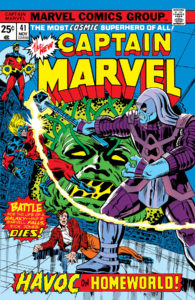 Girl and The Unstoppable Wasp. This week’s installment is the second about CM leading a resistance against a male-chauvinist alien dictator who’s taken over Roosevelt Island in New York City and erected an impenetrable time-slowing barrier around it; this gives Thompson a chance to present Carol as a long-term revolutionary/freedom fighter, an effective and inspiring (and crowd-pleasing) role for her. Captain Marvel is still the subject of a couple of “True Believer” $1 reprint titles this week, too — but it’s the original Kree male version, not Carol Danvers: his origin and first appearance, by the classic Roy Thomas/Gene Colan team, from Marvel Super-Heroes #12, and then an episode from the Steve Englehart mid-’70s era, worth a look for
Girl and The Unstoppable Wasp. This week’s installment is the second about CM leading a resistance against a male-chauvinist alien dictator who’s taken over Roosevelt Island in New York City and erected an impenetrable time-slowing barrier around it; this gives Thompson a chance to present Carol as a long-term revolutionary/freedom fighter, an effective and inspiring (and crowd-pleasing) role for her. Captain Marvel is still the subject of a couple of “True Believer” $1 reprint titles this week, too — but it’s the original Kree male version, not Carol Danvers: his origin and first appearance, by the classic Roy Thomas/Gene Colan team, from Marvel Super-Heroes #12, and then an episode from the Steve Englehart mid-’70s era, worth a look for 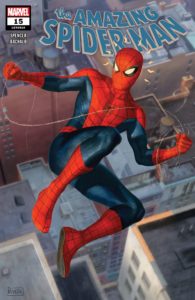 Englehart’s cosmic-poetic style and grasp of the Mar-Vell/Rick Jones relationship, and because Al Milgrom’s pencils, due to deadline problems, got inked by a bunch of hotshot young artists, including Bernie Wrightson, Craig Russell and Terry Austin; playing spot-the-artist from page to page (and sometimes panel to panel) is worth the buck by itself. Of the other Marvel superheroes, both Amazing Spider-Man and Thor are in the middle of longer arcs. Amazing Spider-Man features Chris Bachalo pencils on the Lizard and his semi-reptilian family, Aunt May being indomitable, the brief return of an old supporting-cast member, and the Rhino captured by Arcade, setting up a particularly large-scale version of one of his high-tech traps
Englehart’s cosmic-poetic style and grasp of the Mar-Vell/Rick Jones relationship, and because Al Milgrom’s pencils, due to deadline problems, got inked by a bunch of hotshot young artists, including Bernie Wrightson, Craig Russell and Terry Austin; playing spot-the-artist from page to page (and sometimes panel to panel) is worth the buck by itself. Of the other Marvel superheroes, both Amazing Spider-Man and Thor are in the middle of longer arcs. Amazing Spider-Man features Chris Bachalo pencils on the Lizard and his semi-reptilian family, Aunt May being indomitable, the brief return of an old supporting-cast member, and the Rhino captured by Arcade, setting up a particularly large-scale version of one of his high-tech traps  in partnership with the real bad guy: another old foe who’ll get the spotlight next issue; the plot/subplot serial soap-opera structure is smooth and easy to like, and that Bachalo art even smoother. Thor is building to the company-wide War of the Realms crossover in a month or two, but the current issue is a relatively-quiet (i.e., Odin and Thor spend most of the issue punching one another, but nobody else) meditation on fathers and sons, narrated by Odin, which manages to acknowledge that he’s often been a colossal dick, but at least make us sympathize with him a little more; Mike del Mundo’s watercolors give a subtle heft to the philosophical parts, and a dreaminess to the punching ones.
in partnership with the real bad guy: another old foe who’ll get the spotlight next issue; the plot/subplot serial soap-opera structure is smooth and easy to like, and that Bachalo art even smoother. Thor is building to the company-wide War of the Realms crossover in a month or two, but the current issue is a relatively-quiet (i.e., Odin and Thor spend most of the issue punching one another, but nobody else) meditation on fathers and sons, narrated by Odin, which manages to acknowledge that he’s often been a colossal dick, but at least make us sympathize with him a little more; Mike del Mundo’s watercolors give a subtle heft to the philosophical parts, and a dreaminess to the punching ones.
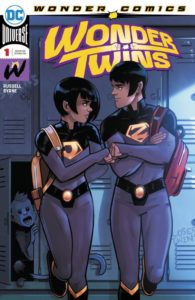 Wonder Twins #1 — Writer: Mark Russell; Art/Colors: Stephen Byrne
Wonder Twins #1 — Writer: Mark Russell; Art/Colors: Stephen Byrne
The Batman Who Laughs #3 (of 6) — Writer: Scott Snyder; Art: Jock; Colors: David Baron
Flash #64 — Writer: Joshua Williamson; Pencils: Rafel Sandoval; Inks: Jordi Tarragona; Colors: Tomeu Morey
Superman #8 — Writer: Brian Michael Bendis; Art: Brandon Peterson; Ivan Reis and Joe Prado; Colors: Alex Sinclair
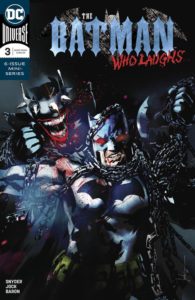 Goddess Mode #3 — Writer: Zoe Quinn; Art: Robbi Rodriguez; Colors: Rico Renzi
Goddess Mode #3 — Writer: Zoe Quinn; Art: Robbi Rodriguez; Colors: Rico Renzi
Wonder Twins follows Zan and Jayna, the two alien siblings familiar to viewers of the old Super Friends TV cartoon and comic (“Wonder Twin powers: activate!”); it’s by Mark Russell, who’s got a reputation for resurrecting old properties (Prez, The Flintstones) into snarky modern-satirical cult hits. The set-up, including the Justice League and the Hall of Justice, is reasonably straight, although it’s melded with a lot of awkward-high-school-student comedy, including elements like the effects of thunderstorms on Exxorians who’ve hit puberty (they get uncontrollable 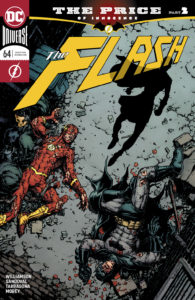 sexual urges); that’s wince-inducing, but then it leads to a scene where both Batman and Superman talk about embarrassing moments during their high-school years, which is surprisingly touching. That’s Russell in a nutshell: sometimes over-the-top, but then human and sympathetic too; it’s not always perfect, but it’s never boring. The Batman Who Laughs has no such variation in tone: it’s Dark-Knight grim all the way through, with the dark-dimension, Jokerized version of Bruce Wayne bringing in other alternate-universe versions to try to take over “our” Batman, Gotham City and the world. Snyder and Jock have teamed up on a lot of similar, and popular, Bat-adventures in the past, and the idea of a Batman with
sexual urges); that’s wince-inducing, but then it leads to a scene where both Batman and Superman talk about embarrassing moments during their high-school years, which is surprisingly touching. That’s Russell in a nutshell: sometimes over-the-top, but then human and sympathetic too; it’s not always perfect, but it’s never boring. The Batman Who Laughs has no such variation in tone: it’s Dark-Knight grim all the way through, with the dark-dimension, Jokerized version of Bruce Wayne bringing in other alternate-universe versions to try to take over “our” Batman, Gotham City and the world. Snyder and Jock have teamed up on a lot of similar, and popular, Bat-adventures in the past, and the idea of a Batman with 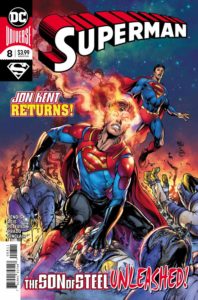 Joker’s insanity and homicidal chaos-view makes this irresistible. Flash continues a Joshua Williamson-penned four-part crossover with the regular Batman title; while not by Tom King, it uses quite a bit of his mythology, so it’s not so much a fill-in as a supplement to the events there — and gets some decent mileage out of a murder mystery utilizing the combined friendship/rivalry between forensic scientist Barry Allen and the similarly-trained Bruce Wayne: both top detectives, even if they don’t always agree. Superman sees super-son Jon Kent, newly-returned from space and suddenly 17 instead of 10 years old, continuing his tale about what happened out there with grandfather Jor-El; it’s the same very smooth, breakneck action and
Joker’s insanity and homicidal chaos-view makes this irresistible. Flash continues a Joshua Williamson-penned four-part crossover with the regular Batman title; while not by Tom King, it uses quite a bit of his mythology, so it’s not so much a fill-in as a supplement to the events there — and gets some decent mileage out of a murder mystery utilizing the combined friendship/rivalry between forensic scientist Barry Allen and the similarly-trained Bruce Wayne: both top detectives, even if they don’t always agree. Superman sees super-son Jon Kent, newly-returned from space and suddenly 17 instead of 10 years old, continuing his tale about what happened out there with grandfather Jor-El; it’s the same very smooth, breakneck action and 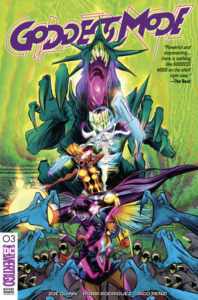 characterization we’ve come to expect from the Brian Michael Bendis Superman books so far. Goddess Mode, a cyberpunk Vertigo title involving a young woman discovering a digital world accessed through a virtual reality/Facebook-type interface, has crammed a lot of intriguing character and cast development into its first three issues, with plenty of twists and high stakes; Robbi Rodriguez’s art, which reminds me a lot of Sean Murphy (Batman: White Knight) handles both the emotional/character moments and the gonzo digital special effects with equal flair, and this comic has a chance to turn into a hit: get it now, while those first few episodes are still available at cover price.
characterization we’ve come to expect from the Brian Michael Bendis Superman books so far. Goddess Mode, a cyberpunk Vertigo title involving a young woman discovering a digital world accessed through a virtual reality/Facebook-type interface, has crammed a lot of intriguing character and cast development into its first three issues, with plenty of twists and high stakes; Robbi Rodriguez’s art, which reminds me a lot of Sean Murphy (Batman: White Knight) handles both the emotional/character moments and the gonzo digital special effects with equal flair, and this comic has a chance to turn into a hit: get it now, while those first few episodes are still available at cover price.
 Vampirella Valentine’s Day Special #1 (of 1) — Writer: Leah Williams; Art: Maria Sanapo; Colors: Ceci de la Cruz
Vampirella Valentine’s Day Special #1 (of 1) — Writer: Leah Williams; Art: Maria Sanapo; Colors: Ceci de la Cruz
Hit-Girl in Hollywood #1 — Writer: Kevin Smith; Art: Pernille Orum; Colors: Sunny Gho
Criminal #2 — Writer: Ed Brubaker; Art: Sean Phillips; Colors: Jacob Phillips
Dick Tracy: Dead or Alive #4 (of 4) — Writers: Lee and Michael Allred; Pencils: Rich Tommaso; Inks: Michael Allred; Colors: Laura Allred
 Strangers in Paradise XXV #10 (of 10) — Creator: Terry Moore
Strangers in Paradise XXV #10 (of 10) — Creator: Terry Moore
Sex Death Revolution #3 — Writer: Magdalene Visaggio; Art: Kasia Witerscheim; Colors: Harry Saxon
Vampirella Valentine’s Day Special isn’t really about romance, although it takes place in New Orleans, where she’s fighting monsters with a local cajun (who talks so much like Gambit that I wondered whether this had started out as a Rogue/Gambit story, and then been repurposed when it didn’t fly in the X-books…); if you can get past the accent, which is (a) rendered phonetically, and hard to 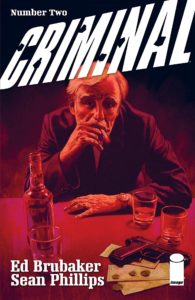 read, but (b) yeah, pretty much how people like that down there talk, it’s not bad, especially as a one-shot — and Maria Sanapo’s art looks quite a bit like Amanda Connors’s in a few places, which is another plus. Hit-Girl in Hollywood gets a mention because it’s written by director/major comics fan Kevin Smith, about our heroine, in the middle of killing various bad guys, finding out that Hollywood’s making an unauthorized movie about her (based on an unauthorized book), and heading west to talk some sense into the suits. This first issue is almost entirely silent, except for the last page, but it’s the usual blood-soaked fun — and the rest of the story, presumably involving Smith skewering various movie-town madmen, should be a hoot, especially if
read, but (b) yeah, pretty much how people like that down there talk, it’s not bad, especially as a one-shot — and Maria Sanapo’s art looks quite a bit like Amanda Connors’s in a few places, which is another plus. Hit-Girl in Hollywood gets a mention because it’s written by director/major comics fan Kevin Smith, about our heroine, in the middle of killing various bad guys, finding out that Hollywood’s making an unauthorized movie about her (based on an unauthorized book), and heading west to talk some sense into the suits. This first issue is almost entirely silent, except for the last page, but it’s the usual blood-soaked fun — and the rest of the story, presumably involving Smith skewering various movie-town madmen, should be a hoot, especially if 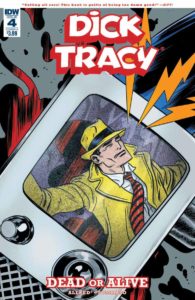 you liked him doing the same thing two decades ago in the Jay and Silent Bob books. Criminal’s new issue begins an arc with similar inside-baseball traits: it’s set at a comic-book convention, where a curmudgeonly older artist’s former assistant gets talked into driving him around for the weekend, and of course bad things begin to happen; Brubaker and Phillips are masterful at combining their usual noir with pop-culture elements (check out their Last of the Innocents graphic novel, which mashed up the Archie cast and hardboiled suspense long before Robert Aguirre-Sacasa and the Riverdale TV show), and, as with Howard Chaykin’s Hey Kids! Comics!, a lot of the fun here is deciding whose stories (Alex
you liked him doing the same thing two decades ago in the Jay and Silent Bob books. Criminal’s new issue begins an arc with similar inside-baseball traits: it’s set at a comic-book convention, where a curmudgeonly older artist’s former assistant gets talked into driving him around for the weekend, and of course bad things begin to happen; Brubaker and Phillips are masterful at combining their usual noir with pop-culture elements (check out their Last of the Innocents graphic novel, which mashed up the Archie cast and hardboiled suspense long before Robert Aguirre-Sacasa and the Riverdale TV show), and, as with Howard Chaykin’s Hey Kids! Comics!, a lot of the fun here is deciding whose stories (Alex 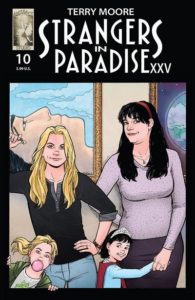 Toth? Wally Wood?) are being mined and combined into fictional truth. Dick Tracy doesn’t try for true crime, so much as over-the-top melodrama, much as Chester Gould’s original strip did: it ends its story here with the square-jawed, unstoppable cop somehow coming out victorious as always, thanks to Rich Tommaso’s pulpy pencils and the Allred family — Michael, Rich and Laura — providing all the rest. Strangers in Paradise XXV ends, too — but also sets up a new story involving, not Katchoo and Francine, but pretty much everybody else in all of Terry Moore’s other projects since then — Echo and Rachel Rising, especially, although Motor Girl‘s in there too — who need to stop a looming, literally universal catastrophe set to occur in five years: an all-star combo cast that fans
Toth? Wally Wood?) are being mined and combined into fictional truth. Dick Tracy doesn’t try for true crime, so much as over-the-top melodrama, much as Chester Gould’s original strip did: it ends its story here with the square-jawed, unstoppable cop somehow coming out victorious as always, thanks to Rich Tommaso’s pulpy pencils and the Allred family — Michael, Rich and Laura — providing all the rest. Strangers in Paradise XXV ends, too — but also sets up a new story involving, not Katchoo and Francine, but pretty much everybody else in all of Terry Moore’s other projects since then — Echo and Rachel Rising, especially, although Motor Girl‘s in there too — who need to stop a looming, literally universal catastrophe set to occur in five years: an all-star combo cast that fans 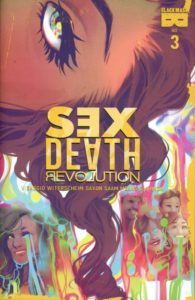 should already be salivating over. Sex Death Revolution started out about a girl involved in magic who suspected that someone was altering her past — but how could you be sure about something like that? — and has morphed into a twisty, psychologically-rich thriller about gender identity and what we think will make us happy, versus what we actually need; it’s not simple, but it’s smart and heartfelt, and it’s one of those stories where you need to get all three of the published issues and read them together to have any hope of figuring out what’s going on. It’s a mini-series, and it’s going to need to stick the landing to be successful, but Magdalene Visaggio’s done it in the past (Kim and Kim; Eternity Girl), so it ought to repay the readers’ efforts here, too.
should already be salivating over. Sex Death Revolution started out about a girl involved in magic who suspected that someone was altering her past — but how could you be sure about something like that? — and has morphed into a twisty, psychologically-rich thriller about gender identity and what we think will make us happy, versus what we actually need; it’s not simple, but it’s smart and heartfelt, and it’s one of those stories where you need to get all three of the published issues and read them together to have any hope of figuring out what’s going on. It’s a mini-series, and it’s going to need to stick the landing to be successful, but Magdalene Visaggio’s done it in the past (Kim and Kim; Eternity Girl), so it ought to repay the readers’ efforts here, too.



